
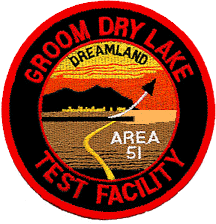


Welcome
to our Area 51 section. The secret airbase that officially doesn't exist!
Here
you'll find the latest satellite pictures, and possible the closest pictures of
the base ever released, radio frequencies
and
information about this top secret base.
|
This enigmatic air-base has become a pivotal piece in the UFO jigsaw. Area 51 is located in Nevada, taking up the kind of acreage that a small country would be proud of, and in fact is the size of Switzerland. Until recently, according to official U.S. statements, it didn’t actually exist. Unofficially it is an operational testing range for the cutting edge technological developments of America’s armed forces. The facilities centred around the Groom Lake area are amongst the most secretive in the world, requiring a level of security so remarkable that Area 51 has become a modern day myth in its own right. |
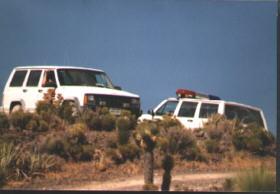 Access
to the base is by authorised personnel only, via a daily shuttle where at least
500 people arrive at the guarded terminal owned by EG&G on the northwest side of
McCarran Airport in Las Vegas, Nevada. Here they board one of a small fleet of
unmarked Boeing 737-200s. Using three digit numbers prefixed by the word "Janet"
as their call signs, the 73s fly off North every half hour. There is no perimeter fence,
just a vast mileage of desert in all directions inaccessible to the public.
Access
to the base is by authorised personnel only, via a daily shuttle where at least
500 people arrive at the guarded terminal owned by EG&G on the northwest side of
McCarran Airport in Las Vegas, Nevada. Here they board one of a small fleet of
unmarked Boeing 737-200s. Using three digit numbers prefixed by the word "Janet"
as their call signs, the 73s fly off North every half hour. There is no perimeter fence,
just a vast mileage of desert in all directions inaccessible to the public.
This ‘no man’s
land’ around Groom Lake is patrolled constantly by infamous camouflaged guards,
(nicknamed cammo dudes) who travel in Cherokee Jeeps to monitor the borders and
stop any unwanted visitors getting inside of the base. They are supported by electronic surveillance
systems, including motion sensors and other monitoring equipment that is said to
have the ability to pick up human sweat. Military units and air
support are also present. Warning signs on the edge of Area 51 tell of heavy penalties
for intruders, including the authorisation for the deadly use of force.
No one denies that the U.S. Government aims to keep this site secure at
all costs. No one gets in. Period. Recently, some very good aerial
satellite images of the area have been available through
Google Earth, which is an amazing 3D map
of Earth that has most areas mapped down to a resolution of just a few thousand
feet. Most of the pictures on this page in fact were captured from the program
because they are the most up-to-date satellite imagery taken of the base. We
highly recommend you to download the program because it can show you the vast
area of the base in great detail.
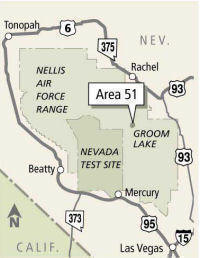 It
is known that a huge hangar is housed within one of the mountains, the doors of
which are closed
when satellites pass overhead. The astronaut Gordon Cooper recently
disclosed that the reason why film taken by him, whilst orbiting in Gemini
5, was confiscated was because he had been inadvertently travelling over
Area 51 at the time. The base boasts one of the world’s longest runways, although
the need for this is not clear unless landings from sub-orbital vehicles
are necessitated. None of this is visible to the public, as the surrounding
vantage points in nearby mountains have been bought up and included within
the perimeter of the vast site. So, given the total paranoia surrounding
its activities, what exactly goes on here?
It
is known that a huge hangar is housed within one of the mountains, the doors of
which are closed
when satellites pass overhead. The astronaut Gordon Cooper recently
disclosed that the reason why film taken by him, whilst orbiting in Gemini
5, was confiscated was because he had been inadvertently travelling over
Area 51 at the time. The base boasts one of the world’s longest runways, although
the need for this is not clear unless landings from sub-orbital vehicles
are necessitated. None of this is visible to the public, as the surrounding
vantage points in nearby mountains have been bought up and included within
the perimeter of the vast site. So, given the total paranoia surrounding
its activities, what exactly goes on here?
According to Bob Lazar, a free-lance physicist and engineer, its activities include reverse-engineering extra-terrestrial craft! He first came forward with these claims in March 1989, when appearing on George Knapp’s news programme on Channel 8, based in Las Vegas. He described his brief time at a facility known as S-4, where he worked on back-engineering exotic craft built to accommodate small beings. Although his credibility has since been questioned by many, notably the nuclear physicist Stanton Friedman, supporting evidence indicates that Lazar did indeed work at S-4, as well as other scientific establishments who initially denied all knowledge of him. It seems that somebody within the Government wanted to remove all evidence of Lazar working at the base, but his name can be found in one of the on-site phone books which dates back to the time that Lazar said he was working there. His academic credentials remain in doubt, although his scientific knowledge is undeniable. It seems that his free-lance working pattern makes him a lower security risk to places like Area 51, simply because he is so difficult to authenticate as a scientist.
Other individuals have since come forward to corroborate a lot of what Lazar claims, although, most of them choose to remain anonymous. As a result, Area 51 is now an intrinsic part of UFO folklore and has done much to support the extra-terrestrial hypothesis. One thing is for sure, many bizarre, seemingly exotic craft have been witnessed, photographed and filmed in the immediate area. The question is, are they the result of extraterrestrial technology or simply our own independent development?
Sceptics point to the emergence of stealth aircraft as a possible example of why Area 51 exists. Although they first saw action during the Gulf War, Lockheed Martin had been secretly developing the technology at “Skunkworks” for many years. The assumption, then, is that the more advanced, exotic vehicles will emerge in the near future when required by the next military enterprise. The problem with this stance is that these vehicles have been witnessed for many, many years and have never been seen to be used. Their advanced capabilities would certainly be of immeasurable benefit to Allied armed forces, but they remain closeted away.
This fuels speculation that the craft are indeed recovered UFOs, or at least our best efforts at emulating the alien technology. After all, the billions of dollars clearly spent on these black projects must produce pragmatic hardware, so their obvious absence from the theatres of war can only be attributed to their sensitive, indeed paradigm-shifting, nature. To use these craft is to admit to their existence, is to admit to the Big Secret. So the whole house of cards is at stake. Even worse, The American public would then realise that billions of their tax-dollars have been covertly spent on reverse-engineering UFOs, with no material benefit to themselves.
The late Colonel Corso would then have claimed that the use of alien technology was indeed seeded into American industry over several decades, but surely this can only be the tip of the ice-berg. Consider the potential uses of advanced propulsion, anti-gravity and alternative energy sources inevitably involved in alien technology. How would the voters react if they were aware that the U.S. Government and military has had access to this potential technology for decades, especially considering the damage to our planet inflicted by the misuse of our current energy resources? The potential ramifications of this discovery are enormous. What President in their right mind would let the cat out of this bag?
Ikonos Satellite Imagery
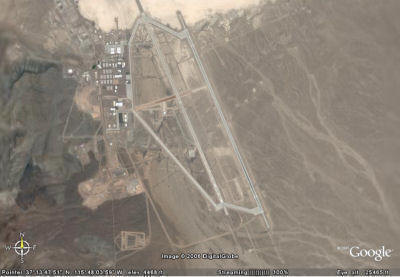 Some
of the best aerial photographs of Area
51 were taken by the Ikonos satellite, which was launched
in September 1999,and the resulting high-definition
pictures were released
to the Federation of American Scientists (FAS) who
commissioned the images. The images offered by the Denver-based company
Space Imaging are able to resolve objects down to one metre across, and
the satellite’s digital camera can be pointed anywhere on the surface of
the Earth. The company offers mass-produced space images for as little
as $10, but will also provide images of targets commissioned by private
individuals or organisations for several hundred dollars. Many of the images on
this page were released in April, 2000.
Some
of the best aerial photographs of Area
51 were taken by the Ikonos satellite, which was launched
in September 1999,and the resulting high-definition
pictures were released
to the Federation of American Scientists (FAS) who
commissioned the images. The images offered by the Denver-based company
Space Imaging are able to resolve objects down to one metre across, and
the satellite’s digital camera can be pointed anywhere on the surface of
the Earth. The company offers mass-produced space images for as little
as $10, but will also provide images of targets commissioned by private
individuals or organisations for several hundred dollars. Many of the images on
this page were released in April, 2000.
Ikonos was launched as a $700m venture by Lockheed Martin and Rayathon. The company counts the US Government as one of its clients. The inclusion of Lockheed Martin as one of the founding organisations is ironic, considering its involvement in sensitive defence contracts in cutting edge aerospace technology. It is also widely understood that Area 51 closes down its operations whenever it is flown over by satellites, but the images will nevertheless be of tremendous interest to all UFO buffs. The FAS campaigns against government secrecy, and have included Area 51 amongst a list of other military installations in North Korea, Iran, Pakistan and India. Their aim is to provide evidence of the spread of sophisticated weaponry around the world.
New Imagery of Area 51 was released on 17 April 2000. The Aerial Images were acquired by Russia's Space Information KVR-1000 satellite system. We have reproduced them here so you can compare how this site has enlarged over the past few years.
New
Runway
One
of the most obvious changes from 1968 to 1998 is the construction of a
new 11,960 foot runway replacing the older 12,400 foot runway 32 Left to
the west. Runway 32 Right. The Southern end of Runway 32R is blackened
with about twice the tire skid marks than at the north end of the runway
suggesting that the prevailing winds are from the north throughout most
of the year. It is not clear how far on to the dry lake the Runway 32 Right
overrun extends. At the south end of 32R there are six final flight check
spaces on the runway apron. At each end of the runway there is a runway
barrier net and arresting cable
|
USGS Aerial imagery |
|
|
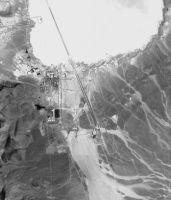 |
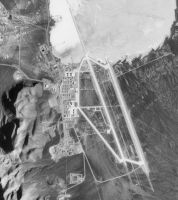 |
|
North
Base
The
four large hangars at the north of the base, present in the 1968 image,
have evidently been enlarged by the time of the 1998 image. In addition,
the housing complex for base personnel -- the large array of smaller buildings
to the south of the hangars, has been entirely rebuilt between 1968 and
1998, with the additional of new support facilities. A B-52 aircraft is
visible in the 1968 image. No aircraft are visible in the 1998 image or
the 2000 scene.
|
|
15 March 1998 - SPIN-2 2-meter |
|
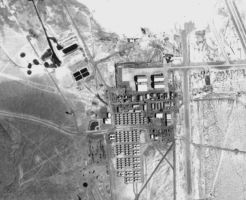 |
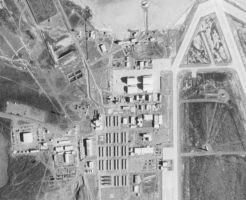 |
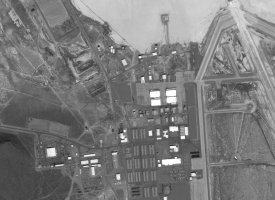 |
South
Base Hangars
Perhaps
the most significant expansion in operational capabilities is noted in
the southern part of the base. The half dozen hangars present in the 1968
image are all evident in the 1998 image, but the total number of hangars
in this area has doubled during the intervening three decades. The most
noteworthy addition is the hangar with the high peaked roof visible in
the top of the 1998 image.
|
|
|
|
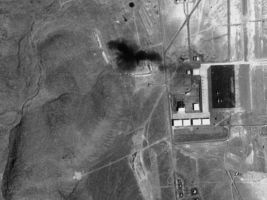 |
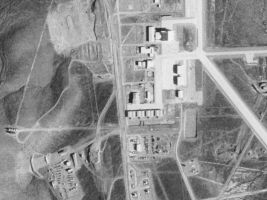 |
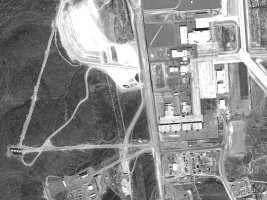 |
Tank
Farm - South Base
The
tank farm visible in the 1968 image, consisting of seven large storage
tanks and three smaller tanks, remains visible in the 1998 image. The wide
separation of the larger tanks is suggestive of fuel for aircraft. The
1988 imagery shows a large asphalt plant, that was used to construct the
new 11,960 foot runway.
|
|
|
|
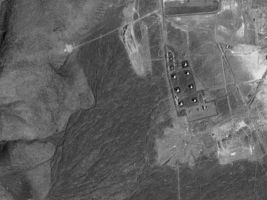 |
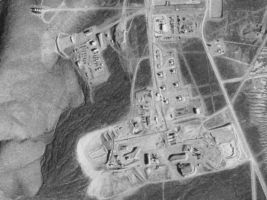 |
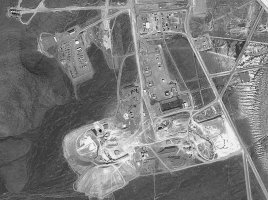 |
New
Construction - South Base
Ikonos
imagery has revealed that this 32 acre facility is a small weapons storage
area with three small igloos and two larger igloos.
|
|
|
|
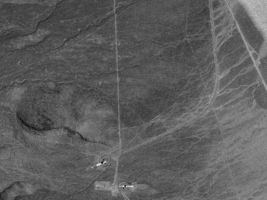 |
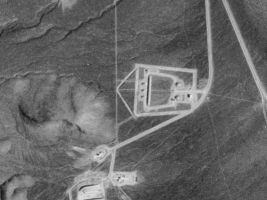 |
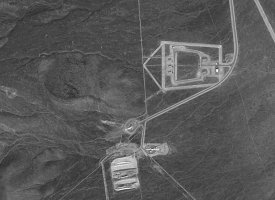 |
Area 51: Up Close And Personal
San Francisco Bay Guardian News May 4-10, 2005
By A. C. Thompson
IT STARTED WITH an e-mail inviting me to join an expedition to Area 51, the secret military site in the Nevada backcountry.
"Let me be clear about this," wrote Trevor Paglen, the 30-year-old geographer leading the trek. "The trip will not be easy. It might not even be that fun, depending on your attitude, how well-prepared you are, and what you consider fun. The weather is unpredictable – it could be really hot or really cold, or (most likely) both.... If you are not in reasonable shape, or are without proper equipment, you will die. Seriously."
 Despite
the less-than-inviting invitation, I was intrigued. For five decades Area 51 has
been the military's heart of darkness, the core of its "black world" of
classified research and development, a place that appears on no maps, and,
officially, has no name. The U.S. government will divulge nothing about the
site, except that it's an "operating location" overseen by the U.S. Air Force.
Everything else – including the most seemingly mundane facts – is classified in
the name of national security.
Despite
the less-than-inviting invitation, I was intrigued. For five decades Area 51 has
been the military's heart of darkness, the core of its "black world" of
classified research and development, a place that appears on no maps, and,
officially, has no name. The U.S. government will divulge nothing about the
site, except that it's an "operating location" overseen by the U.S. Air Force.
Everything else – including the most seemingly mundane facts – is classified in
the name of national security.
The territory in question sits deep in a colossal, small country-size, 3.1
million acre Air Force base northwest of Las Vegas. Built on Groom Lake, a dry
lake bed, Area 51 is bisected by a 27,000-foot runway, studded with massive
hangars and communications towers (which look something like offshore oil rigs
topped by giant scoops of vanilla ice cream), and patrolled by a platoon of
camouflage-clad private security personnel with orders to kill intruders.
Despite the government's omerta-like code of silence, aerospace experts have concluded the isolated, mountain-ringed rectangle of desert served as an incubator for some key cold war machinery, aircraft like the U-2 spy plane and the black-winged, radar-deceiving F-117A stealth fighter.
UFO-heads, of course, have other ideas. For them, Area 51 is the focus of fevered, conspiratorial speculation, a remote and incredibly well-guarded location where the government has hidden a fleet of alien spacecraft. According to this line of thinking, the mysterious lights sometimes spotted blipping across the night sky over Nevada are hot rods from another planet.
After doing a little reading on the place, I knew I had to see it for myself.
Paglen is steeped in the lore surrounding Area 51, the twin currents of secrecy and weirdness that swirl around the place like powdery desert dust. Clandestine military installations are the subject of his doctoral dissertation in geography at UC Berkeley, an endeavour that's propelled him across the American West, mapping the archipelago of bases that dot the landscape. "The whole thing is about getting people to see the world around them differently," Paglen says. "The amount of land devoted to this stuff is gigantic."
To Paglen, a good-humoured Air Force brat with a Woody Woodpecker-ish laugh, Area 51 is many things. It's a pop-culture trope, served up by the X-Files and the 1996 flick Independence Day. A testament to the supremacy over American life of the Pentagon and the Central Intelligence Agency and their corporate pals. A fount of disinformation. One tactic used to shroud zones like Area 51, he argues, "is to make those places very visible in the wrong way – all the UFO stuff at Area 51, for example. Area 51 is far from secret. It's a cliché. But the fact that it's a cliché also hides it."
Declassified CIA documents, Paglen notes, suggest Langley fomented UFO rumours during the 1950s and '60s as a way to deflect attention from the very real flights of experimental aircraft, including the U-2 and A-12 Blackbird spy planes.
 I
met Paglen about 10 years ago when we were both hanging out at East Bay punk
gigs. He's still got a punkish edge, favouring dark jeans and cowboy boots and
punctuating many of his comments with slang and obscenities. All this
camouflages, to some degree, his eclectic braininess: Before pursuing geography,
Paglen earned degrees in religious studies (with a minor in musical composition)
and art. As you read this, the Lab, a San Francisco gallery, is displaying
Paglen's solo show "Recording Carceral Landscapes," a chilling commentary on
California's leviathan prison system.
I
met Paglen about 10 years ago when we were both hanging out at East Bay punk
gigs. He's still got a punkish edge, favouring dark jeans and cowboy boots and
punctuating many of his comments with slang and obscenities. All this
camouflages, to some degree, his eclectic braininess: Before pursuing geography,
Paglen earned degrees in religious studies (with a minor in musical composition)
and art. As you read this, the Lab, a San Francisco gallery, is displaying
Paglen's solo show "Recording Carceral Landscapes," a chilling commentary on
California's leviathan prison system.
In addition to his academic explorations, Paglen also gives informal tours of classified America, journeying to places like the Tejon Ranch Radar Cross Section range (where Northrop tests bleeding-edge aircraft), the headquarters of Science Applications International Corp. (the no-profile defense contractor tapped to set up a TV propaganda network in Iraq), the San Diego docks that are home to the Sea Shadow (a classified Naval watercraft), and the Classic Bullseye listening station (a heavily guarded collection of National Security Agency eavesdropping equipment). He's posted graphics, reports, and pics from all these expeditions on his Web site, paglen.com.
In mid-March I spent three days probing the dark side with Paglen and a crew of 10 other sightseers.
"Uh, guys, we need to be up there," Paglen says, gesturing to the snow-encrusted peak looming above us, "and we're heading downhill."
We're somewhere near the base of Tikaboo Peak, a treacherous 8,000-foot-tall pile of prehistoric rock stippled with scrubby trees. To get to Tikaboo, the vantage point closest to Area 51, we've driven about 120 miles north from Vegas, following a dirt road through the desolate yet gorgeous Nevada wilds, surrounded by an ocean of scrubby vegetation and grainy, sunburned soil.
So far, getting up the mountain has been quite a task – on top of our, ahem, navigational issues, one member of our crew has already vanished (apparently he took off to take a dump), and we've lost any trace of the trail we're supposed to be following. The conditions on this frigid afternoon aren't especially favourable, either. The temperature is dropping rapidly, daylight is dwindling, and three-foot-deep swatches of snow speckle the mountain.
I've managed to pull a Homer Simpson move, leaving my heavy, waterproof coat back in San Francisco. Plus, I'm wearing DC skate shoes, which are already soaked thanks to the snow.
"Have you ever seen any people out here?" one of the expeditioners asks Paglen. "Only once, and it was really crazy," replies Paglen, a charming character with an expansive sense of humour. "We ran into this group of cops from Waco, Texas. They had all these telescopes and high-tech gadgetry."
Cops from Waco, the nexus of myriad conspiracy theories springing from the carnage-laden Branch Davidian debacle, descending on Area 51, the hub of UFO conspiracy theories? Yeah, that's a tad weird.
We tromp on, and by 5:01 p.m. we hit our first stopping point, a peak several hundred feet below the summit. Robby Herbst, the guy who disappeared to make like a bear in the woods, has resurfaced. He's weary from the ascent. "I'm ready for the aliens to take me," says Herbst, an itinerant art professor from Los Angeles, clad in an amazing pair of '70s-era striped jeans. From here the trek gets totally Lord of the Rings, as we traverse an exposed ridgeline punctuated with boulders and begin a steep ascent. At this elevation we're encircled by sky, not trudging beneath it.

After a two-hour scramble up the mountain, we hit the summit with the sun hanging low and look out over a vast plain lined by a few unpaved roads. Dust billows up from one of the roads. Paglen figures it's a government van ferrying Area 51 workers around the base.
Unfortunately, we can't see much more. Our view of Area 51 – which would've been limited anyway – is further obscured by charcoal-coloured clouds pregnant with rain and a thick layer of floating dust. "Can the government make haze?" jokes one guy who flew out from Chicago for the trip.
Paglen has lugged a powerful telescope up with him, so we take turns peering through it, able to make out a handful of structures on a mountainside about 25 miles away. He snaps a digital camera onto the scope and shoots some photos.
The whole deal is fairly anticlimactic; we drove hundreds of miles and dragged ourselves up a fucking mountain, only to be thwarted by Mom Nature? Shit.
Until 1995 you could get substantially closer to Area 51 by ascending White Sides Mountain or Freedom Ridge. Then UFO freaks and stealth-plane watchers began circulating detailed photos of hangars, fuel tanks, runways, and radio towers they'd shot from the two mountains, and the Air Force decided to annex more acreage around Area 51, pushing tourists like ourselves further away. From our perch atop Tikaboo, Paglen dives into the history of Area 51, a locale lacking an official name but endowed with an abundance of enigmatic nicknames including Dreamland, the Dark Side of the Moon, the Box, the Container, and the Ranch.
By any name, the site is testimony to the cozy relationship between the U.S. government and its corporate contractors. "It was originally called the Ranch, and it was started by Lockheed in 1955 because they were developing the U-2 spy plane," Paglen says. "Francis Gary Powers" – the ill-fated pilot shot down by the Soviets in 1960 – "trained here to fly the U-2."
Lockheed (now Lockheed Martin) had been blueprinting and building new planes at the Skunk Works, the company's covert Burbank R&D lab, and testing the experimental craft at Edwards Air Force Base, in the Mojave Desert near Palmdale. But the U-2, a joint project of the CIA and the Air Force, demanded a more private proving ground. The vehicle was an international incident waiting to happen: a camera-equipped aircraft capable of going to the upper regions of the stratosphere (up to 74,000 feet) and bringing home snapshots of the evil empire.
 From
the start, everything was cloak-and-dagger. The Agency bankrolled the base by
writing $1 million in checks to Skunk Works director Kelly Johnson and mailing
them to his Encino home. Johnson in turn made sure Lockheed's fingerprints
wouldn't be on the project by creating a phony front company, C and J
Engineering, which hired builders who erected the basic Area 51 infrastructure
in a matter of months.
From
the start, everything was cloak-and-dagger. The Agency bankrolled the base by
writing $1 million in checks to Skunk Works director Kelly Johnson and mailing
them to his Encino home. Johnson in turn made sure Lockheed's fingerprints
wouldn't be on the project by creating a phony front company, C and J
Engineering, which hired builders who erected the basic Area 51 infrastructure
in a matter of months.
The next radar-eluding craft developed at Area 51, Paglen explains, owed its existence to a set of 1870s-vintage physics formulas. Those formulas, devised by Scottish physicist James Clerk Maxwell and known simply as Maxwell's equations, predict how a surface will reflect electromagnetic waves.
In the 1970s they became the basis for the F-117A stealth fighter when Lockheed engineers used state-of-the-art computers to tweak and extrapolate the equations, hunting for shapes that would scatter and diffuse radar waves. The result was a chunky, flat-angled, Star Wars-esque vehicle, weighing 52,500 pounds (loaded) and measuring nearly 63 feet from nose to tail. It had the "radar signature" of a small bird.
Paglen says, "The stealth fighter became the most secret project since the
Manhattan Project. Ronald Reagan was particularly interested in magic-bullet
technology" like stealth planes and Star Wars missile defence.
In Paglen's estimation, the historic road to Area 51 goes through the labs of Los Alamos, N.M., where J. Robert Oppenheimer and company begat the A-bomb. The Manhattan Project, Paglen writes in an essay for a forthcoming book, was the "first highly-classified, multi-billion dollar [military research] effort.... The Manhattan Project had to manage the thousands of people working on the weapon at any given moment, while restricting the knowledge of the project's true purpose to a very small number of people."
The strategies devised in New Mexico were transplanted to Area 51 and further refined, he says. In some ways the connection between Oppenheimer and Area 51 is even more direct: Area 51 abuts the Nevada Test Site, where, between 1945 and 1992, the government detonated 1,021 nuclear weapons, sprinkling radiation across a vast swath of the Southwest.
Enough about the past. What the hell is going on out here now? Even the experts have few clues.
John Pike directs GlobalSecurity.org, a Beltway think tank, and has been scrutinizing the Pentagon for 25 years. He says that during the Reagan years, analysts could figure out – in broad terms – what the key classified projects were, despite all the secrecy. "Twenty years ago, when there was a big increase in classified spending, we pretty much knew what the programs were," Pike says. "We knew there was a stealth fighter. We knew there was a stealth bomber."
In 1990, he notes, a New York Times reporter was able to pen a 273-page book on the "black budget," the money funneled into clandestine military and spy programs with little congressional oversight.
These days, Pike admits, he's baffled. The military is far more successful at keeping things under wraps. Whatever is going on at Area 51 and similar spots is truly a mystery at this juncture.
"It's certainly a testament to Rummy's ability to keep a secret – that they've been able to spend this money without anybody noticing," Pike says.
And they're spending plenty. The black budget is blimping out to new dimensions. Estimates by the Center for Strategic and Budgetary Assessments, another non-partisan Washington, D.C., think tank, put the total spending for classified weapons programs at $26.9 billion for 2005; for 2006 the Department of Defence has asked for $28 billion.
That's up from a comparatively paltry $11.7 billion a decade ago.
Pike figures a chunk of the increase can be attributed to surging spending on hardware for the intelligence agencies. "You can probably explain half of that from growth in the intelligence budget," he contends, explaining that spook outfits like the CIA and the National Reconnaissance Organization disguise their spending by sticking it in the Air Force's budget.
 And
at least some of the loot is going into Area 51. Pike was one of the first
people to post overhead satellite photos of Area 51 on the Web, paying a Russian
company for pics of the territory shot in 1998 and 2000 and comparing them to
some rare 1968 pics taken by the U.S. Geological Survey. (Apparently, all images
captured by U.S. satellites after 1972 have been deleted from the National
Archives.) From looking at the photos, it's obvious there's been massive
expansion at the site, with new runways and a gaggle of new buildings doubling
the size of the installation.
And
at least some of the loot is going into Area 51. Pike was one of the first
people to post overhead satellite photos of Area 51 on the Web, paying a Russian
company for pics of the territory shot in 1998 and 2000 and comparing them to
some rare 1968 pics taken by the U.S. Geological Survey. (Apparently, all images
captured by U.S. satellites after 1972 have been deleted from the National
Archives.) From looking at the photos, it's obvious there's been massive
expansion at the site, with new runways and a gaggle of new buildings doubling
the size of the installation.
At the Federation of American Scientists, Steven Aftergood has a couple of ideas about what kind of toys the government is blowing our money on. "To start burning up lots of money, you have to be building hardware, and if it's space-based, that's a plus," he says sarcastically.
He points to the outburst of West Virginia senator Jay Rockefeller, who in late 2004 publicly shredded an unnamed covert R&D effort, describing it as "totally unjustified and very wasteful and dangerous to national security." Intelligence analysts quickly connected the dots, theorizing that Rockefeller was pissed about a stealth spy satellite project, an eavesdropping device that, like the F-117A, can avoid detection.
"I think it was mainly supposed to be stealthy in regards to radiation and ground-based detection," says Aftergood, director of the FAS's Project on Government Secrecy.
An earlier project, code-named MISTY, apparently relied on a shield that would "make it difficult or impossible for hostile enemy forces to damage or destroy satellites in orbit." Analysts uncovered that language when the Defense Department stupidly decided to patent the invention in 1994.
In this time of ballooning black budgets, Aftergood says, "first and foremost" we need Congress to watchdog the spooks and warriors. "I think there are legitimate reasons to classify advanced military research. But if they classify it, they need to receive more, not less, scrutiny, even if it's behind closed doors."
Herbst, the art professor, has a burning question for Paglen.
"What's up with the alien shit, man? C'mon, give it up."
Paglen responds, "In 1989 this guy named Bob Lazar came out and said he'd been
working at Area 51 reverse-engineering alien spacecraft. And this story became
incredibly popular."
After giving interviews to local TV and radio in Vegas, in which he claimed to have wrenched on flying saucers stashed near Area 51, Lazar became something of a guru to UFO believers. There was just one problem. His yarn was demonstrably bogus. Lazar wasn't, as he alleged, a physicist. And there were no records of him attending the schools he claimed to have graduated from, Caltech and MIT. Lazar couldn't even keep himself out of trouble with the Vegas cops, who busted him in 1990 for his role in a prostitution ring.
Darkness drops on the mountain. In the distance, down at Area 51, a grid of lights becomes visible. At this point, everyone's ready to go. Unfortunately, most of us have forgotten to bring flashlights, me included. And as the temp has declined, the slushy snow we waded through on the way up has hardened, becoming slick and icy. Getting down isn't gonna be fun.
Twenty minutes into the descent, I'm sliding uncontrollably on my ass down a giant sheet of snow, already bruised from stumbling – "cartwheeling" is more accurate – over rocks and boulders I can't see. I'll be happy if I get out of here without snapping a bone.
After a cryogenically cold night, I stagger from my tent, filthy, sore, and sleep-deprived, but, for some reason, excited to forge ahead. Our first stop is the "front door" of Area 51, located on the unmarked stretch of dirt road we spied last night from Tikaboo. We blast down the road at 60 mph in a convoy of a behemoth Dodge Ram pickup and two SUVs. In front of us the mountains look like giant chunks of coal.
Paglen tells us sensors are buried in the road. On a knoll to our right, a security guard sits in a white truck. He doesn't move or approach us, but it looks like he's surveilling us through binoculars.
Area 51 isn't surrounded by a tall, electrified razor wire-topped fence or any other visible barrier. The front door consists merely of an agglomeration of signs posted on either side of the road. The signs, however, are pretty distinctive. One screams in capital letters, "PHOTOGRAPHY OF THIS AREA IS PROHIBITED." Another notes, "Use of deadly force authorized."
 We
head toward the Little A'Le'Inn, a restaurant-shrine to extraterrestrial
visitors, located in the nearby town of Rachel (population 65), a huddle of
small houses and trailers. Lunch is greasy but good. Two men, obviously
tourists, walk through the door. One is wearing a black T-shirt with a Day-Glo
image of a bug-eyed, big-headed alien. The guy has a shaved head and an outsize
cranium. He looks a little like an alien himself.
We
head toward the Little A'Le'Inn, a restaurant-shrine to extraterrestrial
visitors, located in the nearby town of Rachel (population 65), a huddle of
small houses and trailers. Lunch is greasy but good. Two men, obviously
tourists, walk through the door. One is wearing a black T-shirt with a Day-Glo
image of a bug-eyed, big-headed alien. The guy has a shaved head and an outsize
cranium. He looks a little like an alien himself.
At 9:25 the next morning we lay eyes on the Tonopah Test Range, a second classified installation just down the road from Area 51. Standing atop a butte, I press my eye to Paglen's telescope, focused on a collection of structures jutting up from the plain below, probably 20 miles away. There in the eyepiece are a phalanx of beige-colored aircraft hangars. I can see their sliding doors and get a sense of their enormity. I feel like Indiana Jones.
Paglen goes into tour guide mode. Tonopah, he says, was originally built to "test nuclear triggering devices and delivery devices, any sort of vehicle that would deliver a nuclear payload." When the stealth fighter went operational, Tonopah became the home base for the planes, which retailed at $43 million apiece. "All of those structures you see were created for the stealth fighters. They flew from here to Panama to drop the first bombs in 1989."
In recent years the stealthies have relocated to New Mexico, but Tonopah remains active, and Paglen speculates the Air Force and intelligence services may be perfecting remote-controlled UAVs, or Unmanned Aerial Vehicles, updates of the Predator drones currently plying the skies of the Middle East.
By zooming in on the most exotic zip codes in Pentagonlandia, Paglen runs the risk of overlooking the wider forces at work, the political dynamics fattening the war machine and starving the schools. A month after our return from Nevada, I ask him about this as we cruise 580 in his battered '91 Acura, headed toward Lawrence Livermore National Laboratory.
"I think you're right," he replies. "And that's the trick with this project: to use the places to represent this bigger picture."
Signposts of the garrison state are everywhere, Paglen continues, noting that his office at UC Berkeley is housed in McCone Hall, named after John McCone, a hawk who, during the '50s and '60s, served as undersecretary of the Air Force, chair of the Atomic Energy Commission (the agency chiefly responsible for nuke blasts at the Nevada Test Site), and director of the CIA. "A lot of this stuff is invisible in our daily lives."
Lawrence Livermore is one of those invisible places. While the 53-year-old lab is owned by the Department of Energy and run by the University of California, its primary mission is to build and maintain terrible things that kill people in terrible ways. Here we are, neck-deep in blue-state America, in the über-progressive Bay Area, and aside from a handful of gadflies, nobody gives the Strangelovian bunch at the lab much grief.
You can thank the lab's crafty 22-employee P.R. team for that. They generate a constant stream of press releases about the lab's marginal civilian science effort – researchers who "detect mysterious neutrinos" and explore "diverse ecosystems." Meanwhile, the press flacks don't say a hell of a lot about the arms programs that provide 80 percent of the lab's budget.
Paglen and I pull up at the lab's Discovery Center, a mini-museum with Smithsonian-quality exhibits, which turns to out to be pretty revealing. The prefab brown-and-beige building is stuffed with creepy-ass displays proudly boasting about the facility's starring role in the creation of at least 14 nuclear missiles and bombs, including the charming and obviously Gandhi-esque W87 "Peacekeeper" intercontinental ballistic missile. In the middle of the center is a Death Star-looking mock-up of the lab's National Ignition Facility, a $5 billion laser-equipped nuke-design center.
At the moment, federal budget documents show, the lab is also seeking $4 million for a bunker-busting bomb known as the Robust Nuclear Earth Penetrator.
"This is a big deal," says Marylia Kelley, director of Tri-Valley CARES, an antinuke group. "The Bush administration is explicitly requesting money to go ahead with a new nuclear weapon. It's irresponsible and enormously provocative."
Paglen and I drive off the grounds of the lab, and as the complex recedes from view, our talk turns to topics other than bullets, bombs, missiles, and warplanes. We relish the sun-laden spring afternoon.
As we drive, the old X-Files mantra comes to my mind: The truth is out there. Some of that truth is locked away, far, far out of public view, at Area 51 and Tonopah. And some of it's right out in the open, just a few miles down the road at Lawrence Livermore, where, in the middle of a placid suburb, lab coat-wearing men and women spend their lives devising world-wrecking machines.
Have a nice day.
© Copyright 2005, San Francisco Bay Guardian News
Area 51 Insider Speaks Out
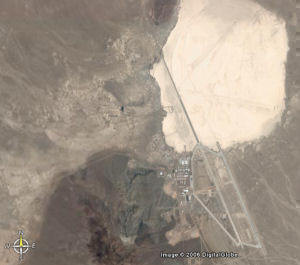
Fouche claims that he was working at Nellis Air Force Base in 1979 when he was told of a reassignment. He and 30 others boarded a blue bus with blacked out windows. Two guards armed with M16 rifles told them not to speak unless spoken to. When they got off the bus he realised he was at the Groom Lake facility. He says conditions were rather oppressive. He was issued heavy glasses, like welders' goggles, which had thick lenses that prevented him seeing further than 10 metres ahead, as well as blocking peripheral vision.
Security
was so tight that he could not go anywhere, not even to the bathroom, without
an armed guard at his side. A key card and code was needed for every door in
the facility, in fact he finds it very hard when so-called former employees
of Area 51 claim to have 'stumbled into a hanger full of UFOs'
During the years 1967-1974, he was stationed or worked at many Tactical Air Command, Air Training Command, and Pacific Air Command Air Forces bases. During the Vietnam conflict, he was assigned to special projects at Kadena AFB Okinawa; Udorn AFB Thailand; Ben Hoi AFB Vietnam, and spent anywhere from a day to a month at many other South East Asian military bases.
With his training and experiences with intelligence equipment, special electronics, black programs, and cryptological areas, he received other government opportunities. He filled positions as Major Command Liaison, Headquarters manager, and DoD factory representative for TAC, SAC, ATC, and PACAF following the Vietnam war. Later in his career, as a manager of defence contractors, he dealt with classified "black" programs developing state-of-the-art Electronics, Avionics, and Automatic Test Equipment. Other research and development programs he worked on as far back as the 70s which are still classified Top Secret. He received over 4,000 hours of technical training from the military and government, of which about half was classified training.
He has found out from sources that an area called the Defence Advanced Research Centre (DARC) exists at Papoose Lake. DARC was apparently built in the early 1980s with Strategic Defence Initiative money. It is 10 storeys underground, and is the control centre for what is called 'Foreign Artefacts', meaning alien artefacts.
Research into crashed or recovered alien technology, back-engineering and the analysis of Extraterrestrial Biological Entities (EBEs) allegedly take place at DARC.
Fouche has recently written a book called 'Alien Rapture - The Chosen', (available to buy at the bottom of this page) with co-author Brad Steiger. Brad is the author of 143 published works including the Best Seller Project Bluebook. Fouche's first job was as a machinist, making bombs for the USAF at R. G. Le Tourneau Industries in Longview, Texas. For the next 25 years he would be involved with the Department of Defence in one way or another. After being drafted into the Vietnam conflict, he initially went through a year of electronics, communications, intelligence, and cryptological schools.
He wrote 'Alien Rapture - The Chosen' during 1994 and 95, after a trip to California, New Mexico, and Nevada. He undertook this trip to do research for the book, which included a meeting with five close friends who had agreed to release confidential information, and discuss their closely guarded personal experiences. Fouche also interviewed other contacts who had worked classified programs or flown classified military aircraft to gather information about UFO sightings and contact. The five friends who had remained close following the Vietnam War, met in the spring of 1990 in Las Vegas
The First friend, Jerald, was a former National Security Agency TREAT Team member. TREAT stands for Tactical Reconnaissance Engineering Assessment Team. He worked for the Department of Energy as a National Security Investigator. That was his cover, but he really worked for the NSA. His job required him to ‘watch employees’ with Top Secret and "Q" clearances at the Nevada Test Site and the Nellis Range which includes Area 51. Area 51 is where the most classified aerospace testing in the world takes place. The base is also know as Groom Lake Air Base, Watertown, the Ranch, or Dream-Land. He was found dead of a heart attack a year after their last meeting.
The Second friend, Sal, was a person who had worked directly for the NSA with Electronic Intelligence (E lent) and became a Defence Contractor after his retirement.
The Third friend, Doc, was a former SR-71 spy plane pilot and a USAF test pilot at Edwards Air Force Base.
The Fourth friend, Dale, was in the services with Fouche during the Vietnam conflict, and had known him since the early 70s.
The Fifth friend, Bud, was a DoD Contractor and Electronics Engineer. He had worked on Top Secret development programs dealing with Electronic Counter Measures, Radar Homing and Warning, ECM Jammers, and Infrared Receivers. He retired as a Program Manager and later died of a brain tumour within 30 days after his symptoms appeared.
Fouche also received input from four other SR-71 pilots, two U-2 pilots, a TR-1 pilot, and about two dozen bomber and fighter jocks. He got the picture of the TR-3B (see picture below) from a person in this latter group.
At the time, he had no intention of writing about programs he was involved with due to the Secrecy Act and classification documents he had signed. However, it bothered each of them that they'd had experiences with unusual phenomena, extremely advanced technology, and witnessed Unidentified Aerial Contact, that had not been previously reported. They agreed to get together again the next year with the understanding that Fouche would contact each of them to set up the meeting. In the meantime, each member of the group, including Fouche, was to write down as much information as he could remember about unusual phenomena and personal sightings.
Many of the things the group revealed to Fouche were startling, and he used this information to piece together the book 'Alien Rapture - The Chosen.'
The SR-71 And UFO Encounter
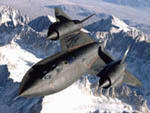 The
SR-71 was designed as a spy plane for the CIA in the 60s and designated the
A-12. The Mach 3 plus aircraft first flew in 1962, taking off from Groom AFB in
Area 51. Later, once the Air Force operated it as a reconnaissance plane, it was
designated the SR-71 black-bird.
The
SR-71 was designed as a spy plane for the CIA in the 60s and designated the
A-12. The Mach 3 plus aircraft first flew in 1962, taking off from Groom AFB in
Area 51. Later, once the Air Force operated it as a reconnaissance plane, it was
designated the SR-71 black-bird.
Fouche's friend, Chuck, a SR-71 pilot, related to him about an in-flight incident he had in the 1970s. He was returning from a reconnaissance flight, and, while at an altitude of 74,000 feet and at the speed of almost Mach 3, (3 times the speed of sound) he noticed something flickering in his peripheral vision. Hovering over his left wing tip was a ball of dense plasma-like light. It was so bright, that when he stared at it for more than a few seconds, his eyes hurt.
Chuck tried to use his UHF, HF, and VHF communications sets to no avail. There was nothing but static. Repeatedly glancing briefly at the ball of light, he watched in amazement as it moved effortlessly about his aircraft. At one point the light positioned itself a few feet in front of the large spiked cone at the air Intake Inlet. The enormous amount of air rushing into the engines should have sucked in, and shredded almost anything in its path, but the light orb was mysteriously unaffected.
The light, he noted, acted in a curious manner, if something inanimate could act at all. It moved from time to time to other parts of the vehicle, staying with him until his approach to Beale AFB in California. He was in sight of the Air Base when the light swung away from his aircraft in a wide arch with ever increasing speed.
Of course, after reading his incident report, his Operations Commander told him not to ever speak about his experience. When Chuck related the story to Fouche, he said he was absolutely convinced that the ball of light was controlled by some form of intelligence. Fouche gathered about two dozen stories from pilots of similar in flight incidents with UFOs and plasma balls.
Flying Triangles
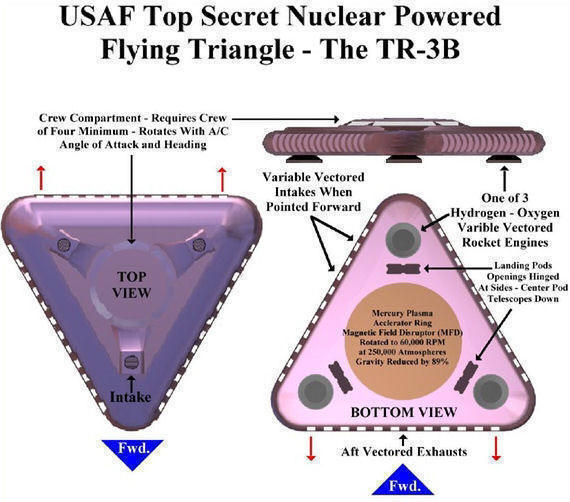 Fouche claims
that he has seen inside information on some of America's most closely-guarded
technological secrets, such as the super-secret SR-71 and SR-75 spy planes and
the incredible UFO-like TR-3B or 'Flying Triangle'.
Fouche claims
that he has seen inside information on some of America's most closely-guarded
technological secrets, such as the super-secret SR-71 and SR-75 spy planes and
the incredible UFO-like TR-3B or 'Flying Triangle'. According to Fouche, the development of the TR-3B began in 1982 and was part of 'Project Aurora'. The aim of 'Aurora' is to build and test advanced aerospace vehicles including the TR-3B, the triangular-shaped nuclear-powered aerospace platform. Apparently around 35% of the US Government's SDI (Strategic Defence Initiative) funds have been siphoned off to help finance it.
The TR-3B is the most exotic aerospace program in existence. 'TR' stands for tactical reconnaissance, which means the craft is designed to get to the target and stay there as long as is necessary in order to send back information. It is powered by a nuclear reactor and can operate for a long time without refuelling. This also allows it to hover silently for long periods. Located in the centre of the triangle is the circular crew compartment and surrounding this is a plasma filled accelerator ring called a Magnetic Field Disrupter (MFD). This generates a magnetic vortex which effectively neutralizes the effects of gravity on mass. The MFD also makes the craft considerably lighter, which means it can out manoeuvre any other conventional craft.
Reduced mass means the craft can fly at Mach 9 speeds vertically and horizontally. The MFD doesn't actually power the craft, it just reduces the mass. The propulsion system consists of three multimode thrusters mounted on each corner of the triangle and gases are used as a propellant. A source who worked on the TR-3B said their goal was to put a third propulsion system on board so you could routinely reach the Moon or Mars.
He explained that it may be possible to modify the MFD technology so that it not only reduces mass, but also creates a force that repels gravity. Therefore this would be a true anti-gravity system, which is believed to be in use by UFOs.
Fouche was considered an Air Force expert with classified electronics countermeasures test equipment, cryptological equipment owned by the National Security Agency, and Automatic Test Equipment. He worked with many of the leading military aircraft and electronics manufacturers in the US. Fouche participated as a key member in design, development, production, and Flight-Operational-Test and Evaluation in classified Aircraft development programs, state-of-the-art avionics, including electronic countermeasures, satellite communications, cryptological and support equipment.
The SR-75
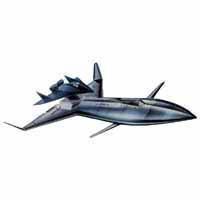 Ed
Fouche claims that Area 51's Groom Lake facility has the massive 6km-long
runway, which makes it the longest in the world, for the
landing of the CIA's latest super-hitech spy plane: the SR-75.
Ed
Fouche claims that Area 51's Groom Lake facility has the massive 6km-long
runway, which makes it the longest in the world, for the
landing of the CIA's latest super-hitech spy plane: the SR-75.
This hypersonic strategic reconnaissance (SR) aircraft is dubbed 'The Penetrator'. It is allegedly capable of positioning itself anywhere in the world within 3 HOURS!!! and can fly at an altitude of 13,000 metres, exceeding Mach 7 speeds of 4,500 kmph. When the US military retired the SR-71 Blackbird back in 1990, it was stated that the aircraft would not be replaced because satellites would now do the job of spying. However, Fouche claims that the SR-75 has been designed to help the CIA/NSA satellites in orbit.
The SR-75 reportedly acts as a mothership from which the unmanned SR-74, or 'Scramp' is launched. The 'Scramp' is operated by remote control and is used to place small satellites in orbit and is said to be able to reach orbital altitudes of 151 kilometres and attain speeds of Mach 15, or just under 10,000 kmph. The plane is so top secret that we could only find an artists impression to illustrate what it looks like. To our knowledge, no publicly available picture exists of this highly top secret plane.
Secret Planes That Helped America Win The Cold War Lie Buried At Area 51
Sunday, March 25, 2001
Las Vegas Review-Journal
By KEITH ROGERS
REVIEW-JOURNAL
As big as football fields and deep enough to bury airplanes, the graves at Groom Lake lie scattered around the government's secret installation, 90 miles northwest of Las Vegas.
There are no headstones or markers to denote the final resting place for such high-tech aircraft as the predecessors to the F-117A Nighthawk stealth fighter jet and the SR-71 Blackbird spy plane.
But people who worked there and researchers who track aviation history and the government's so-called "black budget" programs say some planes that crashed and other experiments that failed were hauled to the bottom of 40-foot-deep holes and covered overnight with mounds of dirt.
One former Groom Lake worker, who spoke on condition of anonymity, said he watched while an earthmover spent a day in 1982 scraping out a burial site.
It was a massive excavation, he said. "They didn't dig that hole and put Martians or moon men in it."
He said the wreckage of a classified plane that was buried on the base was for months in what's called the "Scoot-N-Hide," a shed off a taxiway where secret planes are kept out of view of orbiting satellites.
"They put it on a flatbed truck and put it in a hangar. Then one day they scraped it off the flatbed into the hole and buried it," he said. "They attached a cable to the aircraft and just pulled it off. The thing was shattered like an egg."
According to aviation writer and historian Peter Merlin -- who has obtained declassified flight documents and interviewed personnel involved with Groom Lake programs spanning a period since 1955 -- more than a dozen aircraft are buried around the installation. Combined, the craft were worth at least $600 million and might be valued as much as $1 billion.
This practice of disposing secret, high-tech equipment continues today, he said. "We have no reason to believe it has stopped."
Because it is cloaked in secrecy by a presidential order, Air Force officials will not discuss what it acknowledges only as "the operating location near Groom Lake," which is widely known as Area 51, a 38,400-acre swath of desert along the dry lake bed.
Merlin said the equipment that now lies 40 feet beneath the surface represents cutting-edge technology that in its time kept the U.S. military and the nation's intelligence community ahead of foreign adversaries.
For example, three generations of high-flying spy planes -- U-2s, A-12s, and SR-71s -- have been demonstrated at Groom Lake, each becoming progressively superior to foreign forces. "Nobody ever shot down an A-12," he noted.
Even former Soviet bloc aircraft, such as the 1970s-vintage MiG-23, have been obtained by the U.S. intelligence community and tested at Groom Lake to see how U.S. planes and radar stack up against it, said Merlin, who writes for several aeronautical trade publications, including a newspaper for the NASA Dryden Flight Research Center at Edwards Air Force Base.
The 1982 burial site described by the former Groom Lake worker was near a gravel-pit road and system of trenches where secret documents and materials including drums of toxic coatings for stealth fighter jets were routinely burned for years. A lawsuit by former base workers alleged they had developed illnesses from toxic fumes, but the Air Force has declined to release documents regarding the disposal practice, citing national security concerns.
John Pike, director of GlobalSecurity.org -- a Washington, D.C.-area defence-policy organization, said "the notion that the Air Force is burying its mistakes at Groom Lake makes sense." It is patrolled by helicopters carrying door-gunners manning machine guns.
The Groom Lake graveyard, according to Merlin, includes:
• Several 1960s-vintage A-12s, predecessors of the fast, high-flying SR-71 Blackbird spy planes.
• Four U2s from the 1950s.
• An F-101 chase plane that crashed in 1965.
• Two Have Blue airframes that were used to demonstrate technology for the F-117A.
• Wreckage of a MiG-23 that crashed in 1984.
Merlin and three other sources who worked at the base said base officials wanted to retrieve one of the Have Blue airframes buried somewhere near the Groom Lake installation but were unable to find it.
He said there was a plan to bury a unique surveillance aircraft, Tacit Blue -- a white plane equipped with sensors and radar that could survive flying close to war zones -- but it was rescued and placed in the U.S. Air Force Museum in Ohio instead. Tacit Blue was tested at Groom Lake from 1982 to 1985, he said.
Not all once-secret planes from Groom Lake that crashed have been buried there, including the first production F-117A, tail No. 785, according to Merlin and others who worked at the base at the time.
On April 20, 1982, Lockheed test pilot Robert Riedenauer was at the controls of that plane when it cartwheeled wing over wing attempting to take off from a Groom Lake runway.
To this day neither Riedenauer nor Air Force officials can say where the ill-fated takeoff occurred -- but other sources who worked at the base as well as Merlin say that crash was indeed at the Groom Lake installation.
While Riedenauer can't talk about the crash location he spoke openly about how he escaped death that day, when mis-wired controls caused the craft to go down instead of up.
"I had four seconds to think about it," Riedenauer explained in an interview about his ride aboard the jet.
He said he spent the first two seconds trying to get the craft under control. "The third was reaching for handles to bail out, and the fourth was I realized the aircraft was inverted so it didn't make sense to bail out, so I started shutting down the engine and throttle."
Rescuers managed to save Riedenauer from a fire that flared up. They spent 20 minutes cutting him out of the cockpit. He would spend months in the hospital.
The wings of the $46 million plane were shattered. The plane was to have been the first of 59 stealth F-117As delivered to the Air Force.
Much of it, however, was salvaged and spared from burial, according to Merlin.
The damaged aircraft was returned to Palmdale, Calif., where it now sits on a pylon on display. The first preproduction F-117s have also been converted to displays. One of them, tail No. 780 is at Freedom Park at Nellis Air Force Base.
Bob Pepper, a spokesman for the F-117A stealth fighter jet unit at Holloman Air Force Base in New Mexico, said the policy for disposing of wrecked stealths is to store them temporarily at Holloman and then to follow the procedure for disposing other military aircraft.
The current procedure for disposing of Air Force planes developed from unclassified technology, according to Pike, is to take them to Davis-Monthan Air Force Base near Tucson, Ariz., where they are kept for parts, chopped up and melted down to recycle their aluminium and other metals.
"A stealth composite airplane is not the sort of thing that can be melted down to make pots and pans. You would want to dispose of them so they don't come back to haunt you," he said, explaining that the government's intention is to keep secret materials and components in a secure location so they can't be obtained by other countries.
One former base worker described the 1984 crash of a MiG-23 that ultimately ended up in the Groom Lake graveyard.
"I saw that thing explode," he said. "I was looking up at the sky. I thought, `God, these guys are going fast.'
"Then it was just like it disappeared. The plane came apart. The wings came off it and he punched out," he said, referring to the pilot's fatal bail-out.
Copyright © Las Vegas Review-Journal
UFO flying over Area 51 on video... Watch it perform some incredible manoeuvres
Area 51 Receives Anonymous 162,000 Dollar Cheque
|
Tuesday,
September 12, 2000
The cheque for $162,000 came from nowhere. It represents taxes paid by an unknown contractor doing God-knows-what in the middle of nowhere. But the mystery doesn't bother Lincoln County District Attorney Phil Dunleavy. "The only thing that matters is the cash," he said. Lincoln County officials gladly accepted the money as part of a tax settlement with contractors working at a top-secret facility the Air Force will describe only as "an operating location near Groom dry lake." Former workers at the 38,400-acre Groom Lake installation, most of which sits in Lincoln County, have said it is used to test high-tech U.S. aircraft. The workers have charged that coatings for radar-evading stealth fighter jets were burned in open trenches near the dry lake, 90 miles north of Las Vegas. Dunleavy said Monday he is not at liberty to explain the details of an agreement between the county and an unidentified party over the "use tax," which is similar to a property tax and is charged to contractors that operate on government land. He did acknowledge that negotiations took place and that the tax payment covered the period June 1999 to June 2001. "This is a very poor county, and this is a lot of money for this county," said Dunleavy, who noted Lincoln County is home to about 4,100 residents. "You're going to have to trust Uncle Sam," he said. County Treasurer Kathy Hiatt confirmed that the cheque, made out to "Lincoln County Treasurer," has been deposited at the Bank of America in Pioche. A copy of the cheque - No. 45484, in the amount of $162,065.48 - is dated August 7th and was printed by the Northern Trust Co. in Chicago. It has a vendor number - L00001 - but the name of the party paying the check has been left blank. Hiatt said the "authorizing signature" is by someone whose name appears to be "William F. Neet," and below is the signature of someone named "Dean A." Lincoln County commissioners accepted the cheque at a meeting in August, Hiatt said. County Assessor Bill Lloyd confirmed that the check was for taxes at the Groom Lake installation, commonly known as Area 51. He said the secrecy makes it impossible for county officials to verify whether the contractors are paying their fair share. "It's such a secret place we can't go out there and get the stuff ourselves," Lloyd said. "We just assess them on what they give us, what they figured it's worth ... and then we tax them on it. We just have to take their word." An Air Force spokeswoman at the Pentagon, who was asked about the mysterious check, said last week she was unable to trace it back to Air Force offices in Washington or at the Nellis base near Las Vegas. "It's just highly unusual that the Air Force would issue a check out of a Chicago bank," said the spokeswoman, Capt. Almarah Belk. "It should have a U.S. Treasury seal, if it was an Air Force check," she said. At the Aug. 21 Lincoln County Commission meeting, Dunleavy told commissioners the secret tax agreement stemmed from a 1997 U.S. Supreme Court ruling that found Nevada's use-tax law unconstitutional because it taxed the federal government, not the private contractors who operate at government facilities. Because of the U.S. Supreme Court ruling, the Air Force did not owe Lincoln County taxes from 1972 to 1993. In the meantime, Nevada legislators rewrote the tax law to allow counties to tax federal contractors. According to minutes of the commission meeting, the county struck a deal under which the Air Force would not seek reimbursement for some $664,000 it paid to Lincoln County in taxes from 1972 to 1993. In return, the county would not dock Area 51 contractors for $667,000 in back taxes covering 1994 to 1999. The Air Force agreed that its contractors would pay taxes to Lincoln County on a regular basis. The Air Force has never publicly acknowledged the existence of a "base" near Groom Lake. But on Oct. 26, 1994, after former workers had sued the Air Force claiming they were exposed to toxic fumes from hazardous waste burned in open pits at the installation, the Air Force issued a statement that has become its boilerplate answer to questions about the installation. "There
are a variety of activities, some of which are classified, throughout what
is often called the Air Force's Nellis Range Complex," the statement
said. "The range is used for the testing of technologies and systems
and training for operations critical to the effectiveness of U.S.
"There is an operating location near Groom dry lake. Some specific activities and operations conducted on the Nellis Range, both past and present, remain classified and cannot be discussed," according to the Air Force statement. Thanks to John Richardson for the above article. Strange Things In The Desert During our recent update of this page we came across a great program called 'Google Earth' which has some amazing satellite imagery of the entire World, including this top secret base. On closer inspection of the immediate area surrounding the base, which includes the Tanopah test range and Nellis Air Force base, we noticed some very odd anomalies deep in the Nevada desert and off-limits to non military personnel.
|
|||||||||||